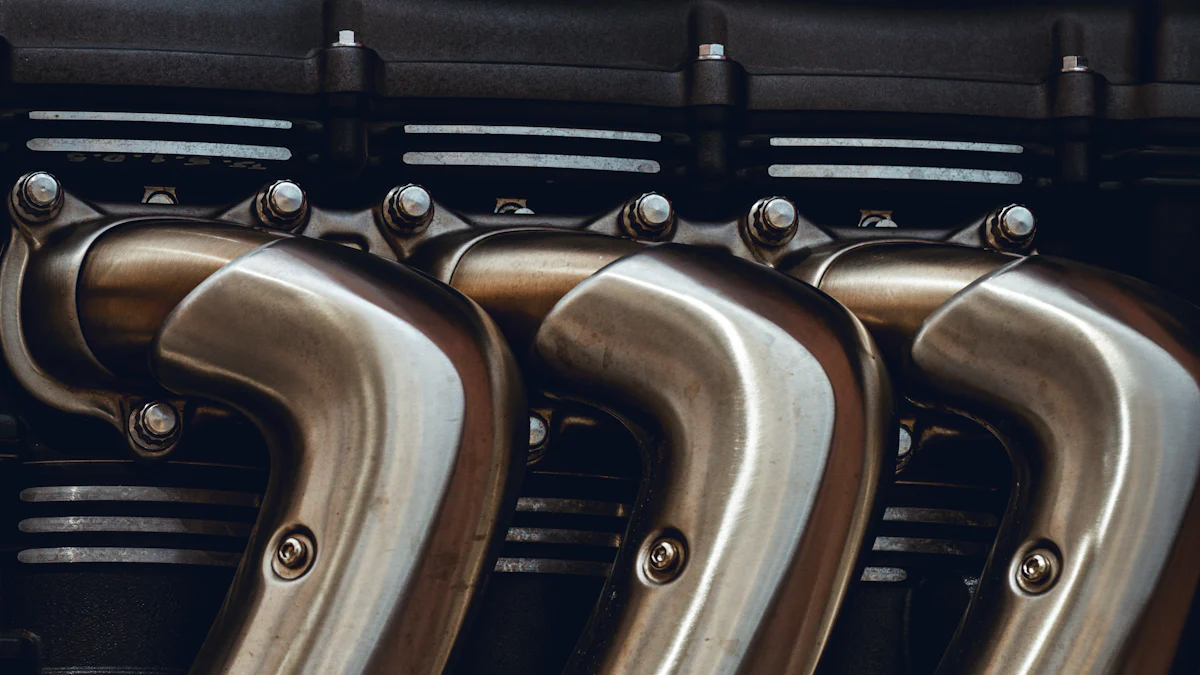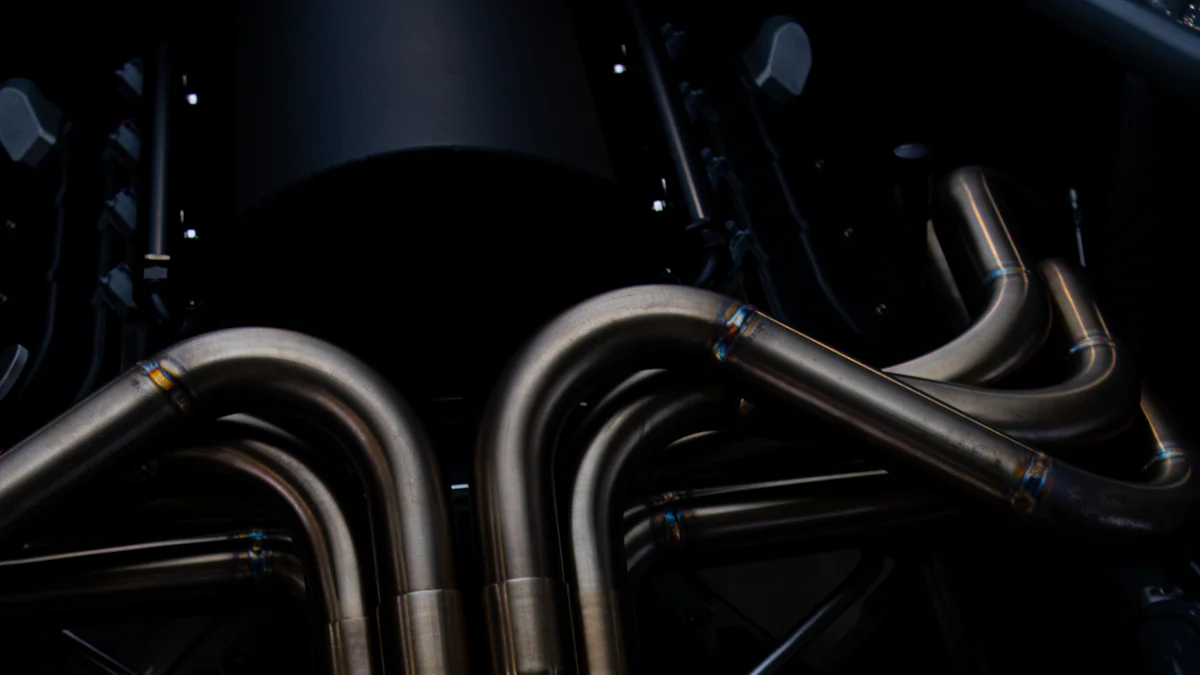
Exhaust systems are essential for your vehicle’s performance, as they manage the flow of harmful gases from the engine, ensuring optimal combustion and reducing carbon emissions. A well-designed exhaust system can significantly enhance fuel efficiency and engine power. In this blog, you’ll explore the differences between exhaust manifolds and headers. These components are crucial in managing back pressure and improving engine performance. Whether you’re interested in a Ford Exhaust Manifold or curious about the Intake Manifold And Exhaust Manifold, this Quick View will provide valuable insights into how these parts affect your wheels’ performance.
Understanding Engine Exhaust Manifold

Definition and Function
What are Engine Exhaust Manifolds?
An Engine Exhaust Manifold is a crucial component in your vehicle’s exhaust system. It collects exhaust gases from multiple cylinders and channels them into a single pipe. Typically made from cast-iron, these thick exhaust manifolds are designed to withstand high temperatures and pressures. They play a vital role in managing the flow of gases, ensuring that your engine operates efficiently.
How do they work in an engine?
In your automobile, the exhaust manifold attaches directly to the engine’s cylinder head. As the engine burns fuel, it produces exhaust gases. These gases exit the engine through the exhaust ports and enter the manifold. The manifold then directs the gases into the exhaust pipe, where they continue their journey through the rest of the exhaust system. This process helps reduce back pressure, allowing the engine to breathe more easily and maintain optimal performance.
Advantages of Engine Exhaust Manifolds
Cost-effectiveness
Exhaust manifolds offer a cost-effective solution for managing exhaust gases. Their simple design and durable materials make them an economical choice for many vehicles. If you’re looking for a Ford Exhaust Manifold, you’ll find that these components provide excellent value for money. They are often less expensive than headers, making them a popular choice for everyday cars.
Durability and reliability
The robust construction of exhaust manifolds ensures long-lasting performance. Made from thick materials like cast-iron, they resist cracking and withstand the high temperatures generated by exhaust gases. This durability makes them a reliable choice for creating high performance wheels, especially in vehicles used for daily driving. You can trust that your exhaust manifold will continue to perform well over time, providing consistent results.
Disadvantages of Engine Exhaust Manifolds
Limited performance enhancement
While exhaust manifolds are durable and cost-effective, they offer limited performance enhancement. Their design can restrict the flow of exhaust gases, creating back pressure that may hinder engine efficiency. For those interested in creating high performance wheels, this limitation can be a drawback. If you’re seeking significant power gains, you might consider alternatives like headers.
Potential for increased backpressure
Exhaust manifolds create some back pressure, which can affect engine performance. This back pressure results from the manifold’s design, which combines exhaust gases from multiple cylinders into a single outlet. While this setup is suitable for many vehicles, it may not be ideal for high-performance applications. If you’re aiming to optimize your vehicle’s performance, you might explore other options that reduce back pressure and enhance exhaust flow.
Exploring Exhaust Headers

Definition and Function
What are Headers?
Headers, often referred to as exhaust headers, are components designed to replace the traditional Exhaust Manifold in your vehicle’s exhaust system. Unlike manifolds, which are typically made from heavy cast iron, headers use thin-walled stainless steel tubing. This construction allows for individual pipes for each exhaust cylinder, promoting better exhaust gas flow. By reducing restrictions, headers help your engine breathe more easily, enhancing overall performance.
How do they improve engine performance?
Headers improve engine performance by minimizing exhaust back pressure. Each cylinder has its own pipe, allowing exhaust gases to exit more freely. This design reduces the resistance that gases face as they leave the engine. With less back pressure, your engine can operate more efficiently, resulting in increased power output. The long primary tubes of equal length in headers ensure that exhaust pulses do not interfere with each other, further optimizing performance.
Advantages of Headers
Enhanced exhaust flow
Headers significantly enhance exhaust flow compared to traditional manifolds. The individual pipes for each cylinder prevent the merging of exhaust gases too early, which can create turbulence and back pressure. This improved flow allows your engine to expel gases more effectively, leading to better combustion and increased efficiency.
Increased horsepower and torque
By improving exhaust flow, headers contribute to noticeable gains in horsepower and torque. With reduced back pressure, your engine can produce more power, especially at higher RPMs. This makes headers an attractive option for those seeking to boost their vehicle’s performance. Whether you’re racing or simply want a more responsive ride, headers can provide the power increase you desire.
Disadvantages of Headers
Higher cost
While headers offer performance benefits, they come at a higher cost than traditional manifolds. The materials and design complexity contribute to this increased expense. If you’re considering upgrading to headers, be prepared for a larger initial investment compared to an Exhaust Manifold.
Installation complexity
Installing headers can be more complex than fitting standard manifolds. The precise alignment required for the individual pipes can make installation challenging. You may need professional assistance to ensure a proper fit and avoid potential issues. Despite these challenges, the performance gains often justify the effort and expense involved in installing headers.
Comparative Analysis: Exhaust Manifolds vs Headers
When deciding between exhaust manifolds and headers, understanding their impact on performance, cost, and suitability for different applications is crucial. This section will guide you through these considerations.
Performance Comparison
Impact on engine efficiency
Exhaust manifolds and headers play distinct roles in engine efficiency. Manifolds, typically found in standard vehicles, manage exhaust gases by combining them from multiple cylinders into a single outlet. This design can create back pressure, which might limit engine efficiency. In contrast, headers reduce this back pressure significantly. Each cylinder has its own pipe, allowing gases to exit more freely. This setup enhances the engine’s ability to breathe, improving overall efficiency.
Influence on power output
Headers offer a noticeable advantage in power output. By minimizing exhaust restrictions, they allow the engine to produce more horsepower and torque, especially at higher RPMs. This makes headers an excellent choice for high-performance engines. On the other hand, manifolds may restrict flow, potentially lowering performance. If you’re aiming for maximum power, headers are the way to go.
Cost and Installation Considerations
Initial investment
When it comes to cost, exhaust manifolds are generally more affordable. Their simple design and durable materials make them a cost-effective choice for many vehicles. Headers, however, come with a higher price tag due to their complex construction and materials like stainless steel. If budget is a concern, manifolds might be more appealing.
Installation requirements and challenges
Installing headers can be more challenging than fitting manifolds. The precise alignment of individual pipes requires careful attention. You might need professional help to ensure a proper fit. Manifolds, with their straightforward design, are easier to install. Consider your mechanical skills and resources when choosing between the two.
Suitability for Different Applications
Daily driving vs performance racing
For daily driving, exhaust manifolds provide reliability and durability. They handle the demands of everyday use without issues. Headers, while offering performance benefits, may not be ideal for non-modified daily drivers. They can cause issues if not carefully researched and installed. For performance racing, headers shine by delivering increased power and efficiency.
Compatibility with various vehicle types
Manifolds are compatible with a wide range of vehicle types, making them a versatile choice. Headers, however, are often tailored for specific high-performance applications. Ensure that headers match your vehicle’s specifications before installation. This compatibility check is essential to avoid potential problems.
In this blog, you explored the differences between exhaust manifolds and headers. You learned that exhaust manifolds offer cost-effectiveness and durability, making them suitable for everyday vehicles. Headers, on the other hand, enhance performance by improving exhaust flow and increasing power output, ideal for high-performance applications. When choosing between the two, consider your vehicle’s purpose and your performance goals. If you prioritize reliability and budget, exhaust manifolds may be your best choice. However, if you seek to boost horsepower and torque, headers could provide the performance edge you desire.
Post time: Oct-21-2024



